Abstract
Enhancing the energy efficiency and climate resilience of existing buildings is crucial amid growing environmental challenges. While extensive research has focused on non-residential buildings, studies on thermo-hygrometric conditions in warehouse-type buildings, particularly in subtropical climates, remain limited. This study investigated the impact of building envelope deficiencies on indoor thermal and moisture regulation at the Nori Distribution Center. Using infrared thermal imaging and long-term environmental monitoring, significant thermo-hygrometric fluctuations were identified, primarily due to design and construction deficiencies. Poor insulation, inadequate sealing, and the lack of moisture barriers contributed to unstable indoor temperature and humidity. Seasonal analysis showed that during summer, the median second-floor air temperature reached 28.8 °C, peaking at 39.2 °C, with relative humidity exceeding 70% for 45% of the time. First-floor relative humidity surpassed 70% for 72% of the time. While condensation risk remains low year-round, it increases significantly with air infiltration through gaps in the building envelope. This study recommends enhancing the sealing of the building envelope, upgrading insulation materials and moisture barriers, particularly in the roof, and optimizing the HVAC system to improve energy efficiency and storage conditions. These findings offer valuable recommendations for retrofitting warehouse-type buildings in subtropical climates to improve energy efficiency and climate resilience.
1. Introduction
As the built environment faces growing demands for sustainability, optimizing the energy performance of existing buildings is crucial for reducing energy consumption and carbon emissions [1,2]. In reflecting on the current capabilities and the possibilities for improving the building stock, it is essential to design buildings that can adapt to climate changes throughout their entire life cycle [3]. Adapting buildings to local climatic conditions—characterized by high humidity, significant temperature fluctuations, and intense solar radiation—presents considerable challenges [4,5,6]. These conditions stress traditional building methods and severely impact indoor thermo-hygrometric conditions, which are essential for occupant comfort [7,8,9,10], material integrity preservation [11,12], and energy efficiency [13].
The built environment plays a crucial role in addressing climate change, particularly in urban areas where dense populations and high levels of human activity intensify environmental pressures. The concentration of population in cities makes them more vulnerable to the externalities of emissions and the impacts of climate change [14]. As a result, cities have become central to both mitigation and adaptation efforts [15]. Mitigation strategies aimed at reducing greenhouse gas emissions are essential for improving energy efficiency and minimizing the environmental impact of buildings [16]. At the same time, buildings in edge-of-city or suburban areas, while exposed to different environmental conditions, face equally significant challenges as cities expand to incorporate rural and industrial zones [17]. Therefore, targeted strategies are necessary to ensure both energy efficiency and the long-term performance of buildings in these regions.
In the context of climate-responsive building design, distinguishing between mitigation and adaptation strategies is critical. Mitigation measures address the root causes of climate change by reducing greenhouse gas emissions and improving energy efficiency [1]. In contrast, adaptation measures aim to enhance a building’s capacity to endure the effects of climate change, maintaining functionality under shifting environmental conditions [18]. To comprehensively address the complexities of climate-related challenges, adaptation must be given equal priority alongside mitigation [19].
With the intensification of these environmental challenges, prioritizing the maintenance, renovation, and retrofitting of existing buildings has emerged as a key strategy to enhance their resilience and sustainability [2,20,21]. By mitigating the impacts of climate on building integrity and functionality and subsequently maintaining optimal thermo-hygrometric conditions, we can ensure the long-term sustainability of the built environment [22,23].
Adaptation strategies of buildings to diverse climatic conditions have been extensively researched, predominantly focusing on residential buildings [24,25,26,27,28]. Although significant attention has been directed toward non-residential buildings [29,30,31,32,33], challenges specific to warehouse-type buildings in subtropical climates are less studied [34]. This research gap is particularly evident in the specific structural and environmental control requirements of warehouse-type buildings, especially in maintaining optimal thermo-hygrometric conditions.
In hot and torrid climates, the internal heat load of commercial and industrial buildings is mainly determined by solar heat gain through the roof, walls, and floors [35,36]. However, the loads that most influence internal temperatures, apart from those entering from opaque structures, are the solar loads entering through windows [37]. Such facilities are typically characterized by large open spaces and high ceilings, which contribute to significant vertical temperature gradients and increase infiltration heat loads due to their small shape factor [38,39]. Additionally, warehouse-type buildings often utilize metal roof panels and lack surrounding shading structures, frequently exposing roofs to prolonged direct sunlight, exacerbating temperature and humidity fluctuations and causing overheating [40,41]. Under subtropical climate conditions, these factors can lead to condensation and mold growth, compromising the structural integrity of the building and reducing product quality [42,43,44,45].
Non-destructive in situ investigations are increasingly recognized as essential for the thermal characterization of building envelopes. These techniques offer significant advantages by allowing the evaluation of thermal performance without causing damage to the structure [46]. Key parameters for thermal characterization include heat flux, which measures the rate of thermal energy transfer per unit area, and thermal transmittance, which quantifies the rate of heat transfer through building materials. Accurate measurement of these parameters is critical for assessing the performance of building envelope components and identifying areas where energy efficiency can be improved [47]. Recent studies have demonstrated the effectiveness of direct and indirect heat flux measurement techniques and highlighted the environmental impact of conducting such tests in existing buildings [48,49].
However, in many existing buildings, due to equipment and cost limitations, in situ measurements can be challenging. In such cases, theoretical methods that calculate thermal resistance and transmittance based on material properties offer a practical alternative [50]. While these methods may not match the accuracy of in situ measurements, they remain useful when direct measurement is not feasible. Furthermore, infrared thermography has been widely applied as a non-destructive testing method for both qualitative analysis and quantitative analysis [51,52,53].
The thermal and moisture management capabilities of the building envelope are crucial for maintaining indoor comfort, especially in regions with challenging climate conditions such as high humidity and temperature variability [54,55]. Improper design or construction can exacerbate the impact of external environmental stresses, leading to heat loss and moisture infiltration in the building envelope, which, in turn, increases energy consumption and accelerates material degradation [51,56]. Therefore, an optimally designed building envelope is essential to withstand harsh environmental stresses and ensure the internal environment necessary for maintaining optimal conditions [53,57,58].
Given the essential role of a well-designed building envelope in maintaining optimal conditions, many industrial facilities are turning to thermal retrofitting and renovation strategies to enhance overall energy efficiency [36,38,59]. However, the variability in the design and operation of warehouse-type buildings, often tailored to specific materials and products, complicates fair comparisons of energy efficiency across different facilities [60,61]. Given these complexities, effective state monitoring and building diagnostics are crucial for ensuring the long-term performance and safety of buildings [51,62]. In summary, managing thermo-hygrometric conditions and mitigating building envelope deficiencies are critical for the long-term stability and efficiency of such facilities, particularly in subtropical climates.
An illustrative example of these challenges is the Nori (dried seaweed) Distribution Center, located in a subtropical zone. This facility is specifically designed to manage the storage, quality control, and pricing of nori—a product highly sensitive to environmental conditions [63,64]. It exemplifies the critical need for building envelope solutions. Inherent deficiencies in its design and construction amplify environmental challenges [65], making the Center an ideal case study to evaluate how the building envelope impacts the operational efficacy, functionality, and long-term viability of warehouse-type buildings in subtropical climates. The building envelope’s role as a key determinant of a facility’s climate responsiveness was a pivotal focus of this research [17].
This study conducted a comprehensive empirical analysis of the Nori Distribution Center, focusing on how deficiencies in the building envelope affect the performance and functionality of the facility under subtropical conditions. It aimed to identify specific deficiencies in the building envelope, analyze their impact under high humidity and temperature fluctuations, and develop targeted improvement strategies. These strategies were designed to significantly enhance the indoor thermo-hygrometric environment, along with the energy efficiency and sustainability of the facility, ensuring that it is better equipped to withstand the climatic conditions of its region. While this study primarily focused on adaptation strategies to improve the ability of the building to cope with the hot and humid subtropical climate, some of the proposed measures, such as enhanced insulation and sealing, also contribute to mitigation efforts by reducing energy consumption and associated emissions. Before beginning renovations, it is crucial to conduct a detailed evaluation of the existing building conditions to accurately determine the necessary modifications and interventions.
The insights derived from this research are intended to provide architects, engineers, and policymakers with actionable, evidence-based information to aid in making informed decisions about adapting warehouse-type buildings to the environmental and energy challenges of subtropical climates.
2. Materials and Methods
2.1. Study Case
This study examined a Nori Distribution Center constructed in 2017 in Kumamoto, Kyushu, Japan. The two-story facility has a total floor area of approximately 4990.76 m2 and a building footprint of 2692.76 m2. It features a steel frame structure with a standing seam interlocking roof made of color-coated Galvalume steel sheets and exterior walls composed of corrugated color-coated Galvalume steel sheets (Figure 1). The facility is located in a predominantly residential and agricultural area, situated away from any high-rise buildings.
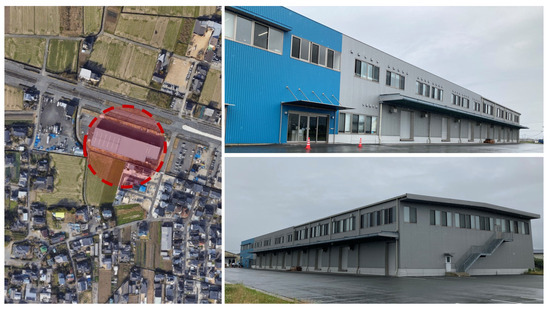
Figure 1.
Building selected for the case study. The red dashed circle highlights the location of the Nori Distribution Center.
The thermal properties of the opaque building envelope components are summarized in Table 1, while the thermal properties of the transparent components (windows) are detailed in Table 2. The calculation of thermal parameters is referenced in Appendix A.

Table 1.
Thermal properties of the opaque building envelope components.

Table 2.
Thermal properties of the windows.
The primary functions of the facility are the storage, quality assessment, and pricing of nori. From late November to April, nori is stored on the ground floor in cardboard boxes and plastic bags, while the second floor contains a specialized inspection room for quality evaluation. Due to the variability of nori quality influenced by weather conditions, the facility urgently needs to maintain strict temperature and humidity controls to standardize the bidding process. This ensures competitive bidding and potentially higher prices for fishermen, promoting improved production techniques and quality management [66].
However, the steel-framed construction, with its corrugated sheet roofing, faces significant challenges in Kyushu’s humid and rainy climate, requiring effective climate control measures. Records indicate issues such as nori shrinkage and the occurrence of condensation, emphasizing the need to address building deficiencies through inspections and corrective actions to improve thermo-hygrometric management and maintain optimal conditions in this subtropical environment.
2.2. Study Area and Climate Condition
Kumamoto, located at 32°48′ N and 130°42′ E, exemplifies the Köppen Cfa climate category, characterized by a humid subtropical climate prevalent in Japan’s Kyushu region (Figure 2). This climate features warm, humid summers and mild winters, consistent with other humid subtropical zones, as evidenced by TMYx data obtained from the online repository https://climate.onebuilding.org/ (accessed on 5 September 2024) [67] and shown in Table 3.
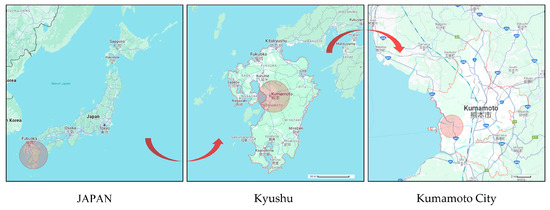
Figure 2.
Location of Kumamoto City.

Table 3.
Climatic data for Kumamoto City.
The TMYx data reveal significant monthly precipitation variations (Figure 3). June sees the highest average precipitation at 448.5 mm during the ‘tsuyu’ period [56], markedly contrasting with January’s low of 57.2 mm. Seasonal variations in solar radiation are significant, with a peak of 18.4 MJ/m2 in May and a low of 8.1 MJ/m2 in December. In June, during the rainy season, sunshine duration significantly decreases to 130.8 h due to increased cloud cover and precipitation, while the peak in August reaches 206.0 h.

Figure 3.
Monthly climatic trends in kumamoto city: precipitation, solar radiation, and sunshine hours.
The TMYx data further show that Kumamoto’s winter air temperature (Ta) typically remains above 0 °C, suggesting a short and moderate winter. In contrast, during the summer, Ta frequently exceeds 30 °C, accompanied by high relative humidity (RH) and a significant increase in precipitation, especially in June. This pattern aligns with the East Asian rainy season, locally termed ‘tsuyu’, which is characterized by extensive rainfall, as illustrated in Figure 3, and high RH, as shown in Table 3.
2.3. Data Collection
This study evaluated the interaction between the building envelope and the thermal-humid environment to assess the impact of the subtropical climate on building performance. The details of the instruments used, including their measurement ranges and accuracies, are provided in Table 4. Initially, we used the FLIR ONE Pro infrared thermography camera, sourced from FLIR Systems, Inc., Wilsonville, OR, USA, to conduct preliminary inspections of the first-floor storage room and the second-floor inspection room, aiming to identify potential thermal bridges and areas of moisture accumulation. Additionally, this study involved a comprehensive evaluation of the design and construction quality of the building envelope. Detailed checks focused on the compliance of materials, accuracy of construction, and integrity of the insulation layer, aiming to address key issues that could undermine the building’s thermal efficiency and indoor comfort [68,69].

Table 4.
Instrumentation for Parameter Measurements.
The core of the research focused on continuous monitoring of key environmental parameters. These parameters include outdoor air temperature (Ta,ex) and outdoor relative humidity (RHex), as well as indoor air temperature (Ta,in) and indoor relative humidity (RHin) for the first-floor warehouse (Ta,in,1 and RHin,1) and the second-floor inspection room (Ta,in,2 and RHin,2). Surface temperature (Ts) measurements were taken for the floors in the first-floor warehouse (Ts,in,f,1) and second-floor inspection room (Ts,in,f,2), the internal surfaces of the external walls in both rooms (Ts,in,w,1 and Ts,in,w,2), and the roof ceiling and beam in the second-floor inspection room (Ts,in,r,2 and Ts,in,b,2). These parameters are critical for maintaining the quality of nori and optimizing the building’s thermal performance. By analyzing the building’s thermo-hygrometric behavior across different time periods, annual monitoring results were obtained, covering seasonal, monthly, and typical weekly patterns. Furthermore, the measurement of Ta and Ts, along with RH, is a well-established diagnostic method for identifying defects [70]. The first-floor warehouse was selected as the main monitoring point due to its location on the ground floor and its frequent operations, which increase its susceptibility to moisture ingress and temperature and humidity fluctuations. Additionally, the first-floor warehouse and the second-floor inspection room are the two largest spaces in the building. The second-floor inspection room, located directly beneath the roof, is prone to solar heat gain, making it a critical area for observing thermal behavior in warehouse-type buildings.
To monitor environmental conditions continuously, a T&D series of high-precision temperature and humidity sensors, including the T&D TR-72nw and T&D TR-71A models, sourced from T&D Corporation, Matsumoto, Japan, were deployed, recording data at 10 min intervals. To ensure the accuracy and consistency of data collection while minimizing disruptions to the routine operations within the facility sensors were strategically positioned (Figure 4).
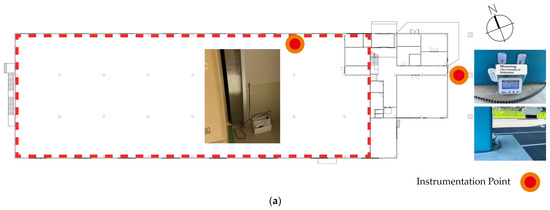
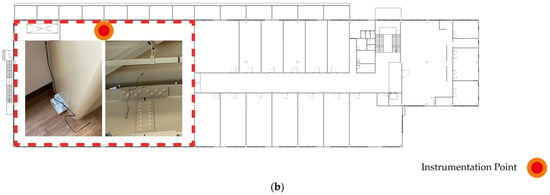
Figure 4.
Layout and instrumentation points for thermal-humidity assessment: (a) first-floor warehouse, (b) second-floor inspection room.
Despite over a year of continuous monitoring, we encountered challenges with data loss, primarily due to equipment failures and restrictions on building access during the COVID-19 pandemic. The initial infrared thermography survey was conducted on 4 June 2021, and continuous temperature and humidity monitoring commenced in July 2021. Following these initial data collection efforts, starting from the winter of 2021, we initiated additional monitoring of the Ts,in,r,2 and Ts,in,b,2 to refine our methodologies. Due to data loss in June 2022, we replicated the monitoring and data collection in June 2023 to supplement the missing information and finalize our annual analysis. Additionally, during this period, we conducted a supplementary assessment of the Ta and RH near the roof ceiling in the second-floor inspection room (Ta,in,r,2 and RHin,r,2). On 26 January 2023, a further infrared thermography survey was performed. In the same month, we implemented temperature and humidity monitoring following the same protocols that we planned for June 2023 to enhance our data collection for the winter season.
2.4. Data Processing and Analysis
After completing data collection, this study utilized Microsoft Excel (version 2021) and Python (version 3.11.5) for data processing, analysis, and visualization. Descriptive statistics were employed to summarize key features of the data, while correlation analyses were conducted to rigorously explore relationships and patterns among the variables.
2.4.1. Calculation Methodology for Air Dew Point Temperature and Humidity Variables
The air dew point temperature () and the absolute humidity () were calculated from the measured parameters using the Tetens (1930) [71] equation as follows:
where is the dew point temperature in the unit of °C, and is the actual vapor pressure in the unit of hPa.
The actual vapor pressure () was calculated using the following equations:
where is the saturation vapor pressure in the unit of hPa, is the relative humidity in the unit of %, and is the air temperature in the unit of °C.
The absolute humidity () was calculated as follows:
where is the saturation vapor density in the unit of g/m3, and is the absolute humidity in the unit of g/m3.
2.4.2. Assessment of Hygrothermal Stability Using Monthly Average Diurnal Range
In building preservation and nori storage, maintaining a stable hygrothermal environment is essential. The Monthly Average Diurnal Range (MADR) serves as an effective indicator for quantifying the stability of hygrothermal conditions. The MADR measures the average daily variation in environmental parameters, representing the diurnal thermal and moisture stability in a building. The calculation is expressed as follows:
where denotes the peak daily value, represents the lowest daily value, and is the number of days in the month.
2.4.3. Analysis of Condensation Risk via Vapor Pressure Ratios
This study investigated the condensation risk (CR) on interior surfaces by analyzing vapor pressure ratios using a bifurcated approach, evaluating both the indoor air vapor pressure relative to the saturation vapor pressure at the interior surface temperature and the outdoor air vapor pressure relative to the saturation vapor pressure at the equivalent surface temperature. Although HVAC systems are installed in the warehouse and inspection room, they are used infrequently. In the facility’s daily operations, the HVAC system is only used from November to April, for four days each month during bidding sessions on the second floor, to optimize indoor conditions. The frequent operation of rolling shutters leads to considerable natural air exchange. In this study, we assumed that the vapor pressure of outdoor air remains unchanged when it enters the indoor environment. While temperature and humidity differences can affect vapor pressure, this assumption simplified our analysis, allowing us to focus on how air exchange impacts CR. This study categorized condensation risk into four levels [58] based on the ratio of actual vapor pressure to saturation vapor pressure:
- Category I, where ratios between 95% and 100% indicate a high likelihood of condensation;
- Category II, with ratios up to 95% suggesting potential condensation;
- Category III, ratios from 85% to 90% denoting probable condensation in the event of significant environmental changes;
- Category IV, where ratios at or below 85% present a low risk of condensation.
3. Results and Discussion
3.1. Qualitative Analysis
This section conducts a qualitative analysis to evaluate the thermal performance and identify potential insulation deficiencies within the nori distribution center. Utilizing infrared thermal imaging surveys, visual inspections, and an extensive review of building design documents, this study uncovered several critical insights. Table 5 outlines the external environmental parameters recorded during the thermal imaging measurement period, with data sourced from the Japan Meteorological Agency [72].

Table 5.
External environmental parameters during the thermal imaging measurement period.
The initial infrared thermal imaging survey, carried out on 4 June 2021, after daytime rainfall and conducted in the evening, revealed that, despite the absence of significant thermal gradients, yellow linear streaks were observed along the roll-up door edges on the first floor (Figure 5(I-a)), indicating air leaks through visible gaps [51]. Ts,in,f,1 and Ts,in,w,1 were lower than Ts,in,c,1 (Figure 5(I-b)), while Ts,in,f,2 was higher than Ts,in,r,2 (Figure 5(I-d)). Additionally, the first-floor foundation rises displayed distinct yellow hues in the thermal images (Figure 5(I-b)), which, upon verification against building design documents, confirmed the absence of insulation material in this area.
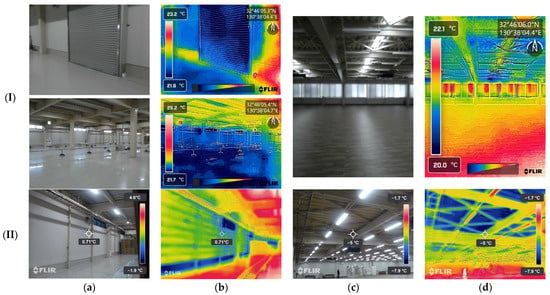
Figure 5.
Qualitative detection of thermal characteristics: (I) 4 June 2021; (II) 26 January 2023; (a,b) first-floor warehouse visible image and thermal image; (c,d) second-floor inspection room visible image and thermal image.
A subsequent thermal survey was conducted on the morning of 26 January 2023, following the coldest day of the year. This survey revealed pronounced thermal anomalies at the first-floor foundation rise and windows (Figure 5(II-b)), suggesting insulation deficiencies. Thermal imaging of the second-floor inspection room (Figure 5(II-d)) showed that Ts,in,r,2 was lower than other Ts, indicating inadequate insulation in the roof structure. The building’s design document indicates that the insulation layer beneath the steel plate roof in the second-floor inspection room is only 4mm thick, with a calculated U-value of 3.70 W/(m2·K), corresponding to a thermal resistance (R-value) of approximately 0.27 m2·K/W. However, the insulation standard for roofs in this type of building in the region requires a minimum R-value of 1.35 m2·K/W, indicating that the current insulation performance falls significantly short of the required standard [73]. Visual inspections also revealed gaps at the joints of the insulation materials.
Additionally, although the exterior walls of the first-floor warehouse and the second-floor inspection room are equipped with breathable waterproof membranes, the absence of moisture barriers undermines the overall moisture control, potentially compromising the effectiveness of insulation and increasing humidity-related issues [74]. Meanwhile, the first floor’s flooring comprises a durable, low-maintenance concrete base with a coated finish designed to support substantial loads, making it ideal for warehouse use. However, the inherent high thermal conductivity of concrete, without adequate insulation, is likely to lead to increased energy consumption and reduced energy efficiency in the building [75]. To enhance energy efficiency and regulate temperature, integrating an insulating layer or thermal barrier is recommended. Additionally, in conditions of high RHin and low Ta,in, the concrete’s propensity to retain cold can lead to condensation formation on the floor surface, further complicating temperature management.
3.2. Indoor and Outdoor Air Temperature and Humidity
Continuous monitoring allowed for the detection of subtle environmental variations, particularly near the roll-up door on the north side of the first-floor storage area and in the corresponding second-floor inspection room.
3.2.1. Air Temperature
A statistical analysis was conducted to assess thermal distribution in the outdoor environment, first-floor warehouse, and second-floor inspection room under subtropical humid conditions across seasons. During summer, no active HVAC systems are used, emphasizing the building’s reliance on passive cooling and insulation. Table 6 highlights the significant seasonal Ta variations.

Table 6.
Seasonal air temperature distributions in various locations.
Ta,in records indicate that, relative to the second floor, the first floor demonstrates a modest level of thermal stability; however, passive thermal management remains inadequate, particularly during periods of peak summer Ta. The second-floor inspection room faces significant challenges, with median Ta,in,2 reaching 28.8 °C during summer and Ta,in,2 spikes up to 39.2 °C. These extreme Ta,in,2 continue into the transitional seasons, with Ta,in,2 peaking at 35.8 °C in autumn and 32.1 °C in spring. Although there are no specific regulations for warehouse-type buildings, researchers caution that Japan’s recommended summer maximum Ta,in of 28 °C, may be insufficient to ensure occupant comfort [10,76].
During the transitional seasons of spring and autumn, while the extremes in Ta are less severe compared with the harsh summer and winter months, the considerable variability within these periods indicates that the current passive environmental control systems struggle to adequately moderate these fluctuations. The consistently higher standard deviations (σ) in Ta,in,2 across all seasons highlight its increased sensitivity to external climatic conditions. By enhancing insulation, particularly on the second floor, peak Ta,in,2 can be reduced, mitigating the risk of overheating during the hot summer months [57,77].
The violin plots shown in Figure 6 present the monthly Ta data across different locations. A violin plot combines elements of a box plot and a kernel density plot, providing a comprehensive view of both the distribution range and the density of the data. The median is represented by a thicker dashed line, while the first and third quartiles (Q1 and Q3) are indicated by thinner dashed lines. The width of each violin plot reflects the density of the temperature recordings, clearly illustrating the frequency distribution within specific temperature ranges.
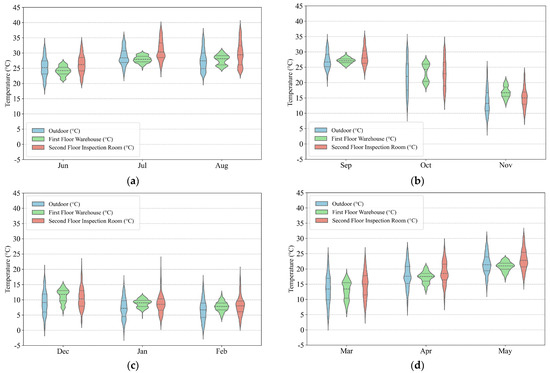
Figure 6.
Monthly Ta distribution of indoor and outdoor environments: (a) Summer: June to August, (b) Autumn: September to November, (c) Winter: December to February, (d) Spring: March to May.
In August, the median Ta,ex reaches 27.4 °C, with peaks up to 36.8 °C, indicating the presence of extreme heat. January contrasts sharply, with median Ta,ex falling to 7.3 °C and lows nearing −2.1 °C, heralding the winter’s chill. Transitional months such as April and October exhibit more moderate Ta,ex fluctuations, with median Ta,ex at 17.6 °C and 22 °C, respectively.
On the first floor, the warehouse experiences a median August Ta,in,1 of 28.1 °C, slightly above the external air, peaking at 31 °C. January’s median Ta,in,1 of 9 °C, with a low of up to 4.3 °C, illustrates some capacity for heat retention, though not markedly superior to external conditions. The first-floor warehouse displays a more concentrated Ta distribution with smaller variations.
The second-floor inspection room shows consistently higher median Ta throughout the year. In August, the median Ta,in,2 reaches 29.4 °C, with highs surging to 39.2 °C, considerably above both Ta,ex and Ta,in,1. This heightened vulnerability to heat is partly due to its elevated position and inadequate roof insulation [35]. In January, the median Ta,in,2 slightly surpasses Ta,ex at 8.5 °C, with a minimum of 1.4 °C. Throughout the year, the extensive Ta,in,2 variations observed in the second-floor violin plots highlight a marked sensitivity to Ta,ex, necessitating a critical reassessment of both insulation and cooling strategies to enhance comfort and operational efficiency [78,79].
3.2.2. Relative Humidity
A year-long analysis at the facility highlighted significant challenges in humidity management. Figure 7 illustrates the monthly distribution of RH values, showing notable seasonal and locational variations.
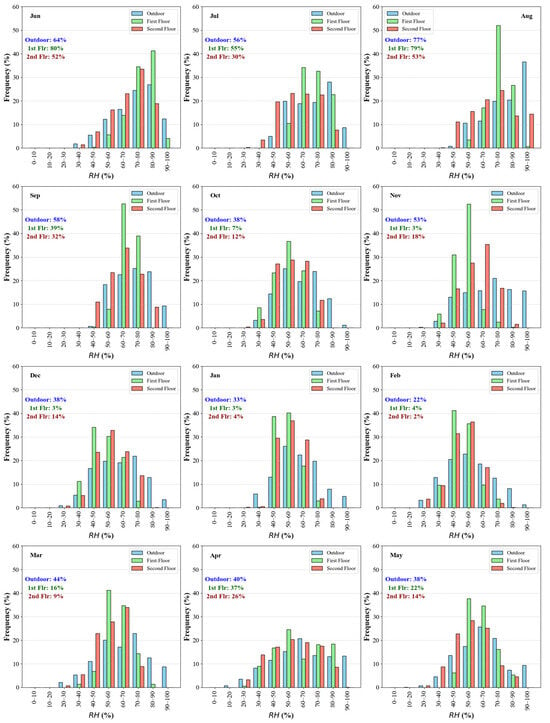
Figure 7.
Monthly frequency distribution of indoor and outdoor RH values. The top left corner values in the figure highlight the frequency of RH reaching the critical high-humidity range (70–100%) across different zones. Blue values show RHex, green values represent RHin,1, and red values indicate RHin,2, representing the proportion of time in each month when the RH exceeded 70%.
While there are no specific standards for RHin, it is crucial to avoid prolonged periods of excessive humidity above 70%, which can increase moisture load and damage the building structure [80,81]. Additionally, it is recommended to maintain RHin below 60%, ideally between 30% and 50%, to ensure optimal conditions and prevent compromises to the quality of nori [82].
In June, July, and August, RHin,1 exceeded 70% for 80%, 55%, and 79% of the time, respectively. RHin,2 exceeded 70% for 52%, 30%, and 53% of the time, respectively. Additionally, in June, 4% of the time, RHin,1 exceeded 90%, while in August, RHin,2 exceeding 90% for 14% of the time.
As temperatures decreased in autumn, 24% of the RHin,1 in October fell within the 60–70% range, with 7% of the time exceeding 70%, underscoring the urgency of enhanced dehumidification efforts before the storage season. The November readings similarly reflected this demand, with 53% of the readings falling in the 50–60% range, necessitating continuous dehumidification. From November to February, the proportion of high RHin,1 significantly decreased. However, RHin,2 exceeded 70% for 18% and 14% of the time in November and December, respectively.
From March to May, RH levels rose in both rooms, with RHin,1 experiencing a higher percentage of time with excessive RH levels compared with RHin,2.
The transition from monthly to seasonal trend analysis highlights that challenges in humidity control are both persistent and seasonally variable. Table 7 shows the seasonal frequency of RH exceeding 50% for both indoor and outdoor environments in the facility.

Table 7.
Seasonal frequency distribution of indoor and outdoor RH values.
During summer, RHin,1 frequently surpassed critical thresholds, with 40% of readings falling within the 70–80% range and 30% within the 80–90% range, posing significant risks of hygrothermal stress to building materials. Similarly, RHin,2 experienced excessive humidity, with 45% of RHin,2 readings exceeding 70%.
In autumn, while RHex levels declined, RHin,1 and RHin,2 still exceeded 70% for 16% and 20% of the time, respectively. Additionally, 28% of RHin,1 and 33% of RHin,2 readings were in the 60–70% range. These findings highlight the need for proactive humidity management to prevent RH from approaching or exceeding the critical 70% threshold, which poses risks to both structural integrity and product quality.
During winter, high humidity levels decreased, though occasional RH peaks of 70–80% were still observed (3% of RHin,1 and 7% of RHin,2). Despite these peaks, 52% of RHin,1 and 59% of RHin,2 remained in the 50–70% range, exceeding optimal conditions for nori storage.
As spring approached, humidity levels increased again, with 61% of RHin,1 and 50% of RHin,2 falling within the 50–70% range. RHin,1 exceeded 70% for 24% of the time, while RHin,2 exceeded 70% for 17% of the time.
From November to April, air conditioning was used on the second floor for four days each month to optimize indoor conditions for preservation. Despite these efforts, the data indicate ongoing challenges in controlling RH. To maintain seaweed quality, RH levels should be kept below 50% in spring and winter and below 70% in summer and autumn to prevent moisture-related damage to both the facility and the product.
3.2.3. Absolute Humidity
During the analysis, it became evident that examining RH levels alone did not fully capture the facility’s indoor moisture conditions. Since RH is heavily influenced by temperature fluctuations, it was necessary to introduce AH levels to obtain a more precise quantification of the actual water vapor content in the air. This approach is supported by studies that emphasize the advantages of using AH for more accurate moisture assessment in environments with temperature variability [83,84].
A detailed boxplot analysis of AH levels, including outdoor AH (AHex), AH in the first-floor warehouse (AHin,1), and AH in the second-floor inspection room (AHin,2), recorded within the facility, is presented in Figure 8, highlighting pronounced seasonal fluctuations. The observed peak in humidity levels during the summer aligns with a scheduled pause in preservation activities, likely attenuating any immediate detrimental effects on product quality. Nonetheless, this period of elevated humidity could compromise the structural integrity of the facility, posing long-term risks.
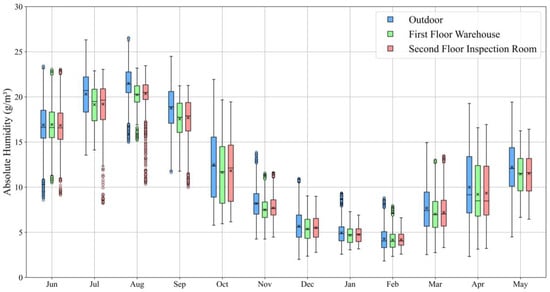
Figure 8.
Monthly Absolute Humidity for Indoor and Outdoor Environments.
The data from the boxplots show a clear reduction in AHin,1 and AHin,2 during the colder months. As temperatures rise, both AH levels and their variability increase, reflecting the complex indoor environmental dynamics. During key preservation months, the boxplot analysis highlights that, although AH levels decrease, the small difference between AHin,1, AHin,2, and AHex indicates deficiencies in the building’s insulation and climate control systems.
Table 8 provides a detailed monthly overview of the differences in AH between indoor and outdoor environments. Specifically, ΔAH1 represents the difference in absolute humidity between the first-floor warehouse and the outdoors, while ΔAH2 denotes the difference between the second-floor inspection room and the outdoors.

Table 8.
Monthly variability in absolute humidity differences between indoor and outdoor environments.
In the early summer month of June, during the rainy season, ΔAH1 exceeds 0 for 54% of the time and ΔAH2 for 48% of the time. By July and August, the occurrence of ΔAH1 exceeding 0 falls below 10%, while ΔAH2 does so for 14% of the time. Throughout the year, the median values for ΔAH2 are consistently higher than those for ΔAH1.
During the crucial seaweed storage season from November to April, the air conditioning system, operational for only four days each month on the second floor, has minimal impact on changing the monthly AH differences between indoor and outdoor settings. During this period, the average values of ΔAH1 range from −0.79 g/m3 to −0.12 g/m3 and ΔAH2 from −0.65 g/m3 to −0.09 g/m3. Indoor AH levels are slightly lower than outdoor levels.
Additionally, both ΔAH1 and ΔAH2 recorded maximum values exceeding 3 g/m3 during the summer and spring, indicating occasional substantial exceedances of indoor over outdoor AH levels. These peaks highlight potential challenges in indoor climate control management.
The current indoor climate control measures seem inadequate in creating a noticeable difference in humidity levels between indoor and outdoor environments, likely due to factors such as limited HVAC operating time, poor insulation, high air exchange with the outside, and the absence of a vapor barrier, all of which make it more challenging to maintain optimal conditions for nori preservation.
3.2.4. Correlation Analysis
The correlation analysis was performed using Python, calculating Spearman correlation coefficients to assess the relationships between environmental variables. This approach provides robust and reliable insights into the data patterns. Heatmaps were generated to illustrate the strength of these correlations, with values ranging from −1.0 to 1.0, representing the Spearman correlation coefficient (ρ). A coefficient close to −1.0 indicates a strong negative correlation, close to 0 indicates no correlation, and close to 1.0 indicates a strong positive correlation. These values are clearly visualized in Figure 9 and Figure 10. In the seasonal analysis, summer (Figure 9a) exhibited an inverse correlation between Ta,ex and RHex, which was more pronounced than in other seasons, highlighting the increased air moisture capacity during warmer periods. In contrast, other seasons showed a weaker Ta,ex—RHex correlation but a stronger link between Ta,ex and AHex.
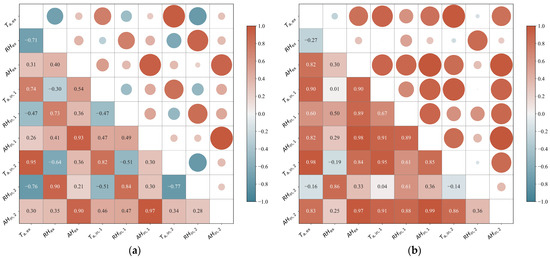
Figure 9.
Correlation analysis of various environmental parameters: (a) summer, (b) autumn.
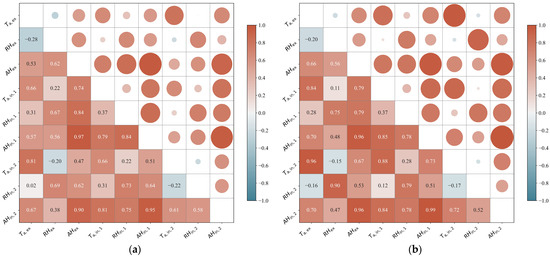
Figure 10.
Correlation analysis of various environmental parameters: (a) winter, (b) spring.
In summer, there was a moderate correlation between Ta,ex and Ta,in,1 with ρ = 0.74, while Ta,ex and Ta,in,2 showed a stronger correlation of ρ = 0.95, indicating that Ta,in,2 is more sensitive to Ta,ex changes, likely due to inadequate roof insulation.
As shown in Figure 9b, in autumn, AHin,1 demonstrated a significant positive correlation with AHex at ρ = 0.98, indicating a marked responsiveness to AHex fluctuations. The exceptionally high correlation coefficient of ρ = 0.99 between the AHin,1 and AHin,2 suggests a uniform humidity response throughout the building. Additionally, Ta,in,2 demonstrates a robust positive correlation with Ta,ex at ρ = 0.98, and RHin,2 shows a substantial correlation with RHex at ρ = 0.86.
In winter (Figure 10a), the correlation between Ta,in and Ta,ex diminishes, with the first floor at ρ = 0.66 and the second floor at ρ = 0.81. The decrease may be influenced by various factors. However, without further investigation, it remains unclear whether the HVAC system adjustments—specifically, four days of heating per month to accommodate winter conditions on the second floor—played a significant role. Additionally, the strong correlation between AHin,1 and AHex (ρ = 0.97) and between AHin,2 and AHex (ρ = 0.90) highlights significant challenges in regulating indoor humidity.
In spring, as illustrated in Figure 10b, Ta,in,1 (ρ = 0.84) and Ta,in,2 (ρ = 0.96) demonstrate strong positive correlations with Ta,ex, indicating the building’s significant thermal response to external temperature fluctuations. Notably, RHin,2 exhibits a pronounced correlation with RHex at ρ = 0.90, highlighting its heightened sensitivity to springtime humidity changes. Despite the air conditioning system being operational for four days each month on the second floor during March and April to modulate the indoor climate, the persistent strong correlations, particularly with RH, suggest that intermittent HVAC operation has limited effect on modifying springtime indoor humidity levels. This pattern suggests that intrinsic structural attributes, such as insulation quality and moisture management efficiency, play a pivotal role in shaping the indoor climate.
The precise correlations between indoor and outdoor conditions show that deficiencies in insulation and moisture control exacerbate the impact of external environmental variations. Ta,in,2 and Ta,ex and RHin,2 and RHex consistently show stronger correlations compared with Ta,in,1 and Ta,ex and RHin,1 and RHex, indicating that the second floor is more sensitive to external fluctuations. A previous study [85] used correlation analysis to focus on the energy demands and thermal performance of opaque building elements. In contrast, our research examined the relationship between indoor and outdoor conditions, specifically how temperature and humidity interact with insulation performance and moisture control, with attention to seasonal variations and their effect on indoor climate stability.
3.2.5. Stability Analysis
In the depiction of the MADR of Ta in Figure 11, significant outdoor diurnal temperature fluctuations are observed, peaking at 10.61 °C in October. The MADR of Ta,in,1 varies from 1.57 °C to 2.94 °C, with its annual peak occurring in December. Notably, during the critical seaweed storage period from November to April, the first-floor warehouse exhibits elevated MADR of Ta,in,1. In the second-floor inspection room, there is even greater temperature variability during the spring months, with the maximum MADR of Ta,in,2, recorded at 8.49 °C in April. This pronounced thermal volatility on the second floor, present throughout the year, is primarily due to inadequate insulation in the building envelope, leading to increased heat gain and heat loss. Similar findings have been noted in studies on building envelope deficiencies, which highlight the significant impact of poor insulation on indoor temperature fluctuations and energy efficiency [53,86].
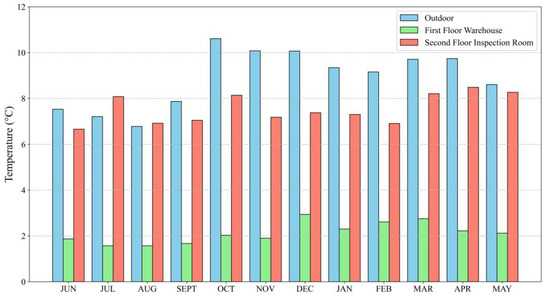
Figure 11.
MADR of Ta.
As shown in Figure 12, the MADR of RHex fluctuates significantly throughout the year, peaking at 45%. This high variability persists during the critical seaweed storage months. RHin,1 exhibits a MADR ranging from 8% to 15%, aligning with the external trend. In contrast, RHin,2 experiences a broader range of 18% to 28%, underscoring ongoing challenges in maintaining humidity stability. This issue of humidity variability has also been observed in other studies that focus on moisture management in non-residential buildings, where insufficient insulation and air leakage can lead to significant humidity fluctuations and increased moisture load [58,87].
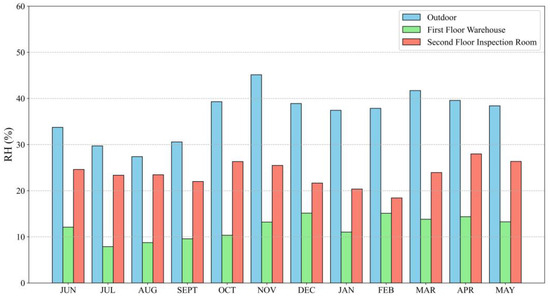
Figure 12.
MADR of RH.
The MADR of AH, measured in g/m3 and presented in Figure 13, displays notable variability outdoors, spanning from 1.98 g/m3 to 4.73 g/m3, with a notable peak in May. Indoors, the AH MADR values exhibit an increasing trend of variability from winter to spring. The differences between the AHin,1 MADR and the AHin,2 MADR are relatively minimal, with values spanning from 1.06 g/m3 to 2.27 g/m3 and 1.21 g/m3 to 2.59 g/m3, respectively.
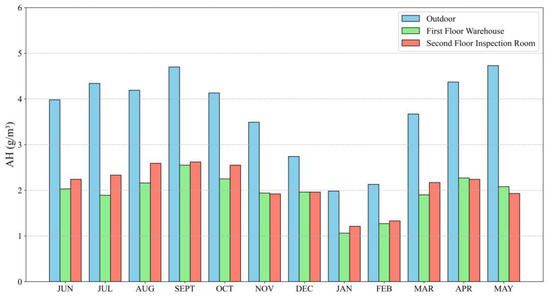
Figure 13.
MADR of AH.
The MADR analysis for Ta, RH, and AH reveals that the second-floor inspection room consistently experiences greater environmental variability than the first-floor warehouse, subjecting stored goods and building materials to heightened environmental stress. The disparity between the first and second floors underscores the critical need for advanced hygrothermal management strategies, especially for upper floors that are more exposed to dynamic external conditions. Previous studies [12,39] have emphasized the need for improved hygrothermal regulation in buildings exposed to vertical environmental gradients and external stressors, highlighting the importance of both thermal and moisture management in maintaining a stable indoor climate.
3.3. Analysis of Indoor Condensation
3.3.1. Air Dew Point Temperature (DP) and Surface Temperature (Ts)
Figure 14 illustrates the cumulative distribution functions (CDFs) for DP and Ts across summer (Figure 14a) and autumn (Figure 14b). Higher DP indicates a greater amount of moisture in the air, indirectly reflecting humidity levels [88].
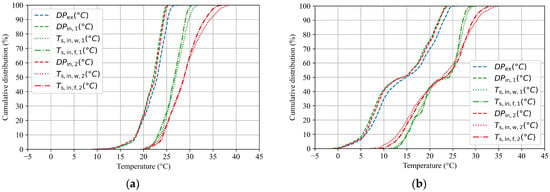
Figure 14.
Cumulative distribution functions of DP and Ts: (a) summer, (b) autumn.
In summer, the median outdoor DP (DPex) of 22.95 °C reflects the season’s high humidity, as shown in Figure 14a. Inside the building, the median DP on the first floor (DPin,1) is 22.15 °C, and the median DP on the second floor (DPin,2) is slightly higher at 22.48 °C, indicating marginally lower indoor humidity levels compared with outdoors. The median Ts,in,w,1 and median Ts,in,f,1 were 27.0 °C and 26.7 °C, respectively, while the median Ts,in,w,2 and Ts,in,f,2 maintained a consistent 28.7 °C. With Ts,in,w,2 reaching a peak of 38.7 °C and Ts,in,f,2 reaching 36.8 °C, this indicates severe overheating due to poor insulation, far exceeding comfort and functional requirements, and compromising overall thermal management.
Entering autumn, the median DPex decreased to 14.87 °C, reflecting the season’s cooler, drier air, as depicted in Figure 14b. Internally, the building mirrors this trend, with a median DPin,1 of 14.03 °C and DPin,2 slightly lower at 13.98 °C. Despite cooler external temperatures, the surfaces in the second-floor inspection room maintain relatively high temperatures, with median Ts,in,w,2 at 22.6 °C and median Ts,in,f,2 at 23.2 °C.
In the winter analysis, as depicted in Figure 15a, the minimum DPex dropped to −12.57 °C. The median DPin,1 was slightly lower than the outdoor condition at −0.12 °C, while the median DPin,2 was 0.03 °C. Critical minimum Ts were recorded at 3.3 °C for Ts,in,w,1 4.1 °C for Ts,in,f,1, and 0.6 °C for Ts,in,w,2 and 2.2 °C for Ts,in,f,2. The proximity of these temperatures, as shown in Figure 15a, underscores the necessity for improved insulation or targeted heating interventions to prevent cold spots and mitigate the risk of internal condensation, especially when humid air enters the building.
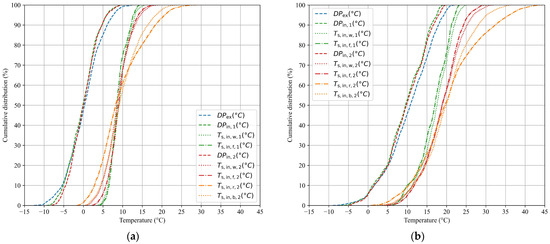
Figure 15.
Cumulative distribution functions of DP and Ts: (a) winter, (b) spring.
Transitioning into spring, the median DPex rose to 10.74 °C, reflecting the shift towards warmer and more humid conditions, as illustrated in Figure 15b. This increase in humidity necessitates a thorough examination of the building’s capacity to maintain a condensation-free environment. The spring minimum surface temperatures—5.1 °C for Ts,in,w,1 and 6.2 °C for Ts,in,f,1 and 3.2 °C for Ts,in,w,2 and 4.7 °C for Ts,in,f,2—underscore the challenges posed by these conditions.
The analyses for winter and spring include an examination of Ts,in,r,2 and Ts,in,b,2. The Ts,in,r,2 exhibits extreme fluctuations, highlighting the issue of insufficient roof insulation. The lack of adequate insulation and moisture barriers exacerbates indoor thermal and humidity issues.
3.3.2. Condensation Risk
Assess the risk of condensation with a comprehensive seasonal analysis conducted on wall and floor surfaces within spaces that typically do not use HVAC systems. This evaluation involves both indoor and outdoor air conditions and includes calculating the following:
- The ratio of indoor air vapor pressure to the saturation vapor pressure at the interior surface temperature;
- The ratio of ventilated outdoor air vapor pressure to the saturation vapor pressure at the same interior surface temperature.
Data from these calculations were then categorized into four distinct risk levels, from Category I—indicating the highest risk of condensation—to Category IV—representing the lowest risk, as depicted in Figure 16 (note: Category IV is omitted in the figure). This approach and categorization follow the analysis detailed in Section 2.4.3, where vapor pressure ratios were used to evaluate CR levels.
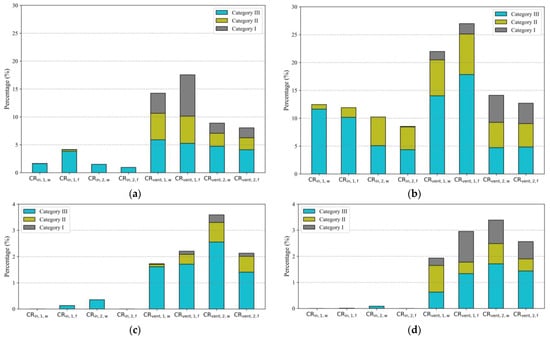
Figure 16.
Frequency statistics of CR categories on indoor surfaces by season: (a) spring, (b) summer, (c) autumn, (d) winter. ‘in’ denotes indoor air and ‘vent’ stands for ventilated outdoor air. ‘1′ and ‘2′ refer to the first-floor warehouse and the second-floor inspection room, respectively. ‘w’ represents walls, and ‘f’ denotes floors.
Seasonal changes significantly impact the risk of condensation within the building. In spring observations, as shown in Figure 16a, CRin,1,w and CRin,1,f, as well as CRin,2,w and CRin,2,f, predominantly fell into Category IV, representing minimal risk, with frequencies nearing 98% or higher. However, the influence of ventilated outdoor air, denoted by ‘vent’, indicates an increased risk of condensation. For instance, CRvent,1,f rose to 7.404%, markedly contrasting with its counterparts influenced by indoor air.
During summer, as illustrated in Figure 16b, CR values vary; most indoor surfaces remain within lower-risk categories. CRin,1,w, CRin,1,f, CRin,2,w, and CRin,2,f generally fall into Category IV, with frequencies ranging from 87.55% to 91.47%. However, surfaces exposed to ventilated outdoor air exhibit noticeable Category I risks, notably for CRvent,2,w and CRvent,2,f, with respective frequencies of 4.86% and 3.67%. Category II and III risks also appear, with CRvent,2,w and CRvent,2,f recording 4.55% and 4.21% in Category II and slightly higher in Category III at 4.71% and 4.83%, highlighting potential CR under conditions such as open doors and windows that raise humidity levels.
In autumn, Figure 16c shows a predominance of Category IV across various surfaces, indicating a very low risk of condensation overall. While most surfaces marked with ‘vent’ remain in Category IV, the 2.55% Category III risk for CRvent,2,w, underscores the subtle impact of external factors on increasing CR.
During winter, the CR on indoor surfaces predominantly falls within Category IV, as illustrated in Figure 16d. However, surfaces influenced by ventilated outdoor air, particularly CRvent,1,f and CRvent,2,w, exhibit slight increases in higher-risk categories. Specifically, these surfaces exhibit marginal Category I risks at 1.18% for CRvent,1,f and 0.90% for CRvent,2,w, respectively. Although these percentages are minimal, they underscore that the infiltration of cold outdoor air can escalate the risk of condensation during the colder months [33].
3.4. Typical Weeks
Typical weeks are selected based on regional climate characteristics and patterns, ensuring that the architectural design and assessment fully account for the impacts of climatic conditions on building performance. The data from Figure 17, Figure 18, Figure 19 and Figure 20 demonstrate variations in Ta, RH, and AH during these weeks across different seasons at the Nori Distribution Center, emphasizing the significant influence of climate on the building’s environmental functionality.
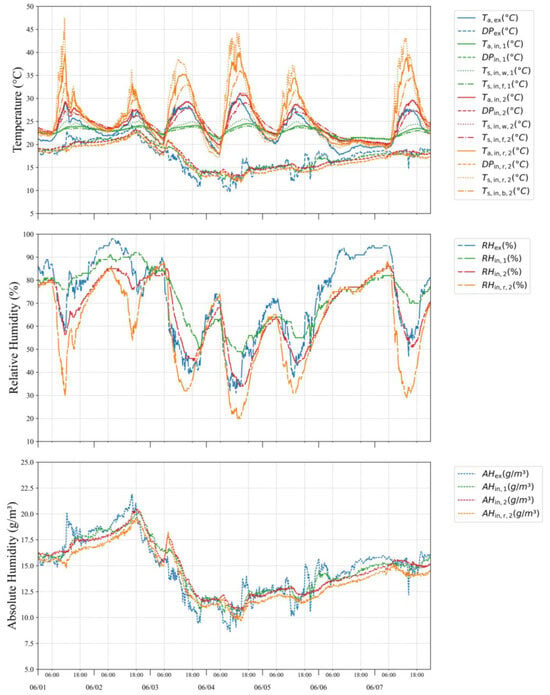
Figure 17.
Variation in environmental parameters during early summer (rainy season), 1–7 June 2023.
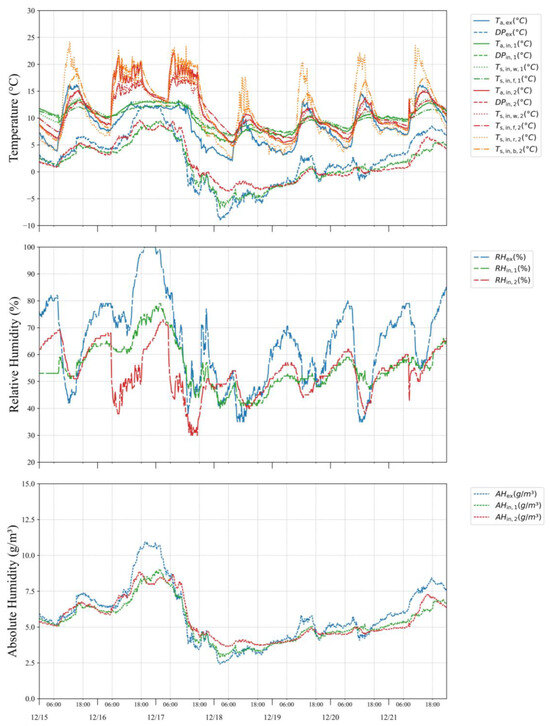
Figure 18.
Variation in environmental parameters during winter (including heating days), 15–21 December 2021.
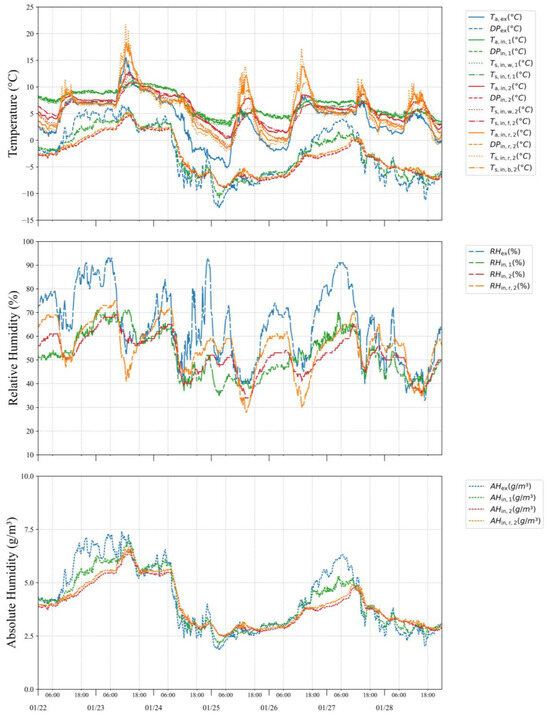
Figure 19.
Variation in environmental parameters during winter, 22–28 January 2023.
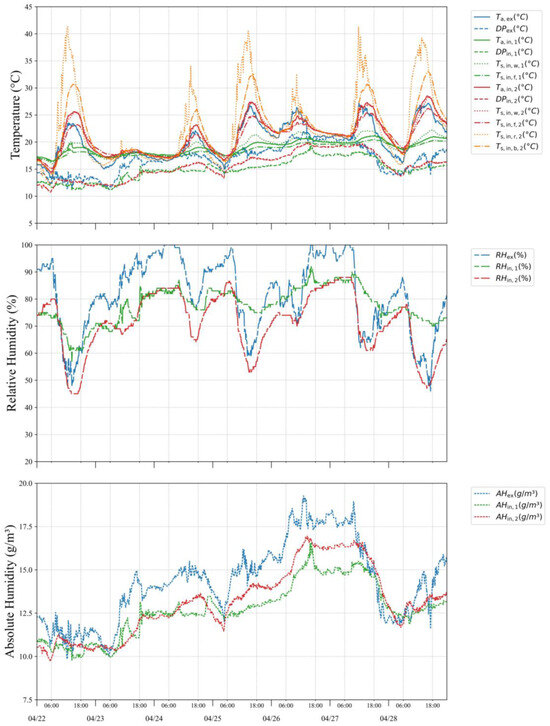
Figure 20.
Variation in environmental parameters during spring, 22–28 April 2022.
3.4.1. Early Summer (Rainy Season)
During the early summer rainy season, data depicted in Figure 17 indicate that the HVAC system was inactive within the building. Ta,ex showed significant fluctuations, peaking at 30.0 °C, with an average of 23.3 °C and a nocturnal low of 17.7 °C. Inside, the first-floor warehouse maintained a relatively stable thermal environment, with an average Ta,in,1 of 22.9 °C. In contrast, the second-floor inspection room recorded a higher average Ta,in,2 of 24.6 °C and exhibited greater temperature variability than the first-floor warehouse. These data clearly highlight significant thermal stratification within the building, particularly near the second-floor roof ceiling, where Ta,in,r,2 soared to 40 °C and RHin,r,2 reached 88%.
The fluctuations in Ts of the walls were greater than those of the floors. Ts,in,r,2 peaked at 47.4 °C, primarily due to direct solar radiation and inadequate roof insulation. Such high temperatures, combined with high humidity, create localized hot zones within the building, thereby increasing the demand for cooling. The AH levels inside the building were very close to those outside, indicating that indoor humidity is significantly influenced by outdoor conditions. On days with elevated RHex, the indoor DP closely approached both the Ta,in and Ts,in, indicating a concerning level of moisture accumulation.
3.4.2. Winter
During the observed week in winter, as depicted in Figure 18, the building’s second-floor air conditioning system executed significant heating cycles on the 16th and 17th during daytime hours.
Ta,ex varied between 2.0 °C and 16.2 °C, with an average of 8.9 °C. RHex averaged 65%, reaching full saturation at its peak. Inside, the first floor maintained an average Ta,in,1 of 10.0 °C, slightly above the Ta,ex, suggesting a stable yet minimally insulated environment. RHin,1 levels were consistently above the optimal level most of the time, necessitating the implementation of dehumidification measures for the warehouse.
During HVAC operations on the second floor, significant temperature fluctuations were observed, especially a rapid cooling phase after reaching the set temperature and switching to air supply mode. These abrupt fluctuations indicate the weak thermal mass of the building envelope and poor insulation performance [86].
The winter Ta, RH and AH data, as shown in Figure 19, reveal significant deficiencies in environmental control, failing to meet the strict requirements for nori storage. Ta,ex showed significant variations, averaging 3.9 °C, ranging from −5.2 °C to 15.5 °C. Ta,in,1 exhibited a narrower range of 2.7 °C to 11.2 °C, averaging 6.8 °C. In contrast, the fluctuations in Ta,in,r,2 were greater, ranging from −1.5 °C to 18.3 °C. The indicating that strong solar radiation during the day leads to increased temperatures, while radiative cooling at night exacerbates heat loss.
RHex also varied significantly, between 33% and 93%, with an average of 64%. RHin levels frequently exceeded the optimal 50% threshold for nori storage, with RHin,1 averaging 52% and peaking at 71%. RHin,r,2 averaged 56%, reaching highs of 75%. Figure 19 demonstrates that RHin closely mirrors outdoor variations. However, compared with the second floor, the first floor exhibits more frequent fluctuations in humidity, indicating an inability to maintain stable conditions within the building. This disparity highlights the urgent need to improve environmental management strategies to ensure humidity control across all floors.
3.4.3. Spring
Throughout the observed week in spring, the building’s environment, as depicted in Figure 20, experienced varied conditions reflective of typical spring weather.
Ta,ex ranged between 13.1 °C and 27.2 °C, indicative of moderate to warm days with cooler nights. Notably high RHex, averaging 82% and occasionally reaching full saturation at 100%, was mirrored indoors, especially with average RHin,1, recorded at 78%. These conditions underscore the challenges of managing indoor humidity in a persistently moist external environment, particularly in areas lacking adequate moisture control measures.
During this period, a significant condensation event was recorded around 08:50 a.m. on 27 April, following an afternoon of rainfall on 26 April that continued into the early morning. This saturation of the outdoor atmosphere, coupled with cooler nighttime and early morning temperatures, heightened the risk of condensation. Despite relatively stable Ta,in,1, DPex surpassed Ta,in,1 and Ts,in,f,1 from approximately 06:00 a.m. on 26 April to 10:00 a.m. on 27 April. This disparity, together with high external humidity, fostered conditions conducive to moisture condensation on cooler surfaces within the warehouse. The occurrence of condensation also underscored structural vulnerabilities in the building, such as inadequate vapor barriers and air leakage points, particularly around roll-up doors. These deficiencies facilitated the ingress of humid external air, which, when meeting the cooler internal surfaces, led to condensation.
The observed data highlight the critical need for enhanced environmental management strategies to ensure stable humidity levels across different building zones and to mitigate structural vulnerabilities that exacerbate moisture issues.
Autumn was not included in the detailed weekly analysis because its temperature and humidity levels are not as extreme as those observed in other seasons. This relative mildness diminishes its impact on energy efficiency and thermo-hygrometric conditions, making it less relevant for in-depth study.
4. Conclusions
This study examined the impact of building envelope deficiencies in warehouse-type buildings situated in subtropical climates using a nori distribution center as a case study. Employing infrared thermography alongside continuous monitoring of temperature and humidity, complemented by both qualitative and quantitative analyses, this research delineated how such deficiencies compromise indoor thermal and humidity stability. This, in turn, impairs energy efficiency and the preservation of sensitive products.
Deficiencies in insulation, sealing, and moisture barriers during design and construction substantially compromise temperature and humidity control. The negligence of warehouse building managers in limiting the operating time of HVAC systems (in the context of misunderstood “savings”) and the lack of care for proper thermal insulation and humidity control can lead to inappropriate food storage conditions and related financial losses.
Infrared thermography was employed to qualitatively assess thermal anomalies in the building envelope. The thermal images revealed air leaks, insufficient sealing, and thermal bridges, particularly around the roll-up doors and wall joints. These images clearly identified locations of heat loss and air infiltration, especially on the roof. Such qualitative data guided the identification of areas requiring immediate retrofitting. To complement the infrared thermography, U-value calculations were performed to quantify the thermal transmittance of key building components. The U-value for the roof was measured at 3.70 W/m2·K, which significantly exceeds the regional standards. This discrepancy underscores the urgent need for improvements in insulation. Inadequate insulation in the roof, walls, and floors leads to significant heat accumulation and loss.
Seasonal analysis indicates that during the summer, the average temperature on the second floor reaches 28.8 °C, peaking at 39.2 °C. Surface temperatures on the wall and the floor reach maximum values of 38.7 °C and 36.8 °C, respectively. During transitional seasons, temperatures can reach up to 35.8 °C in spring and 32.1 °C in autumn. Temperature monitoring of the ceiling and beams on the second floor shows pronounced fluctuations exceeding those of other indoor surfaces, underscoring the inadequate roof insulation. Although the first floor exhibits more stable temperatures than the second floor, its thermal performance remains deficient.
The risk of condensation remains generally low; however, it is significantly exacerbated by the frequent opening of entrances and the infiltration of warm, humid air through gaps in the building envelope due to sealing deficiencies. High humidity poses a major concern during summer, with the first floor exceeding 70% relative humidity 72% of the time and the second floor 45% of the time. This issue is similarly pronounced during spring and autumn. Correlation analysis highlights the building’s heightened sensitivity to external climate variations. Mean Absolute Daily Range analysis demonstrates significant fluctuations in indoor temperature and humidity, underscoring the building’s instability due to structural deficiencies. By analyzing the building’s thermo-hygrometric behavior across different time periods, annual monitoring results were obtained, covering seasonal, monthly, and typical weekly patterns.
To address these challenges, we recommend comprehensively sealing gaps in the building envelope to prevent the ingress of warm, moist air. Upgrading the insulation materials and installing effective moisture barriers will further enhance the building’s ability to regulate indoor temperature and humidity. Optimizing the existing HVAC systems will improve energy efficiency and reduce operational costs. These measures are expected to create better conditions for storing temperature-sensitive products like nori. Focusing on the roof is particularly important, as it plays a pivotal role in managing the thermal and humidity environment of warehouse-type buildings.
In conclusion, this study highlights the broader implications of building envelope deficiencies for warehouse-type buildings in subtropical climates. Prior to implementing targeted retrofitting and design improvements, conducting low-cost assessments of existing deficiencies is essential to inform targeted interventions. This preliminary assessment ensures that any proposed retrofits are based on a thorough understanding of the existing problems, thus enhancing the functionality, sustainability, and environmental resilience of these facilities.
5. Limitations and Future Works
This study identified several key areas where future research could expand upon the findings. First, while the thermal properties of the opaque elements of the building were the primary focus of this investigation, future studies should consider more detailed monitoring of window surface temperatures. Given the significant role that windows play in heat gain, a comprehensive assessment of their contribution to indoor temperature fluctuations could offer valuable insights into improving overall building performance.
Second, employing more advanced non-destructive in situ heat flux measurement techniques can more accurately analyze thermal bridging and heat flow patterns in building envelope components. This approach helps identify potential weak points that may exacerbate energy inefficiency and indoor discomfort, thereby facilitating more targeted building interventions.
Lastly, future research could explore the implementation of improved insulation materials, vapor barriers, and HVAC strategies specifically tailored to the needs of warehouse-type buildings in subtropical climates. Simulations and case studies based on the findings of this study could provide a clearer understanding of the long-term energy efficiency gains and thermal comfort improvements achievable through targeted building envelope enhancements.
Author Contributions
Conceptualization, Y.X. and H.F.; methodology, Y.X. and H.F.; software, Y.X. and T.Y.; validation, Y.X. and H.F.; investigation, Y.X. and H.F.; resources, H.F.; data curation, Y.X. and T.Y.; writing—original draft preparation, Y.X.; writing—review and editing, Y.X., H.F. and X.W.; visualization, Y.X.; supervision, H.F.; project administration, H.F.; funding acquisition, H.F. All authors have read and agreed to the published version of the manuscript.
Funding
This research received no external funding.
Data Availability Statement
The data presented in this study are available on request from the corresponding author.
Conflicts of Interest
The authors declare no conflict of interest.
Appendix A
The heat transfer coefficient is given by the formula [89]:
where the following is true:
is the heat transfer coefficient (W/m2·K);
is the external surface heat transfer resistance (m2·K/W);
is the internal surface heat transfer resistance (m2·K/W);
is the thermal resistance of layer in part of section (m2·K/W), calculated as follows:
where is the thickness of layer (m), and is the thermal conductivity of layer (W/mK).
Therefore, the surface heat transfer resistance on the external boundary of the general section and the surface heat transfer resistance on the internal boundary of the general section are values defined in Table A1 and Table A2, based on the Japanese Energy Conservation Law for Buildings (current version) [90].

Table A1.
Surface Thermal Resistance.
Table A1.
Surface Thermal Resistance.
| Element | Internal Surface Thermal Resistance (m2·K/W) | External Surface Thermal Resistance (m2·K/W)—Direct Air Exposure | External Surface Thermal Resistance (m2·K/W)—Other Conditions |
|---|---|---|---|
| Roof | 0.09 | 0.04 | 0.09 (e.g., air gap) |
| Ceiling | 0.09 | - | 0.09 (e.g., attic space) |
| External Wall | 0.11 | 0.04 | 0.11 (e.g., air gap) |
| Floor | 0.15 | 0.04 | 0.15 (e.g., subfloor layer) |

Table A2.
Surface Thermal Resistance (Boundary and Floor Partitions).
Table A2.
Surface Thermal Resistance (Boundary and Floor Partitions).
| Element | Surface Thermal Resistance (Target Zone Side) (m2·K/W) | Surface Thermal Resistance (Adjacent Zone Side) (m2·K/W) |
|---|---|---|
| Boundary Wall | 0.11 | 0.11 |
| Upper Floor Partition | 0.09 | 0.09 |
| Lower Floor Partition | 0.15 | 0.15 |
References
- Hashempour, N.; Taherkhani, R.; Mahdikhani, M. Energy Performance Optimization of Existing Buildings: A Literature Review. Sustain. Cities Soc. 2020, 54, 101967. [Google Scholar] [CrossRef]
- Li, Q.; Zhang, L.; Zhang, L.; Wu, X. Optimizing Energy Efficiency and Thermal Comfort in Building Green Retrofit. Energy 2021, 237, 121509. [Google Scholar] [CrossRef]
- Díaz-López, C.; Verichev, K.; Holgado-Terriza, J.A.; Zamorano, M. Evolution of Climate Zones for Building in Spain in the Face of Climate Change. Sustain. Cities Soc. 2021, 74, 103223. [Google Scholar] [CrossRef]
- Wang, X.; Zhang, L.; Su, X.; Yang, H. Daylighting and Energy Performance of the Window with Transparent Insulation Slats in the Humid Subtropical Climate Zone. Energy Build. 2023, 300, 113685. [Google Scholar] [CrossRef]
- Zhou, Y.; Herr, C.M. A Review of Advanced Façade System Technologies to Support Net-Zero Carbon High-Rise Building Design in Subtropical China. Sustainability 2023, 15, 2913. [Google Scholar] [CrossRef]
- He, Y.; Wang, Z.; Wong, H.M.; Chen, G.; Ren, C.; Luo, M.; Li, Y.; Lee, T.; Chan, P.W.; Ho, J.Y.; et al. Spatial-Temporal Changes of Compound Temperature-Humidity Extremes in Humid Subtropical High-Density Cities: An Observational Study in Hong Kong from 1961 to 2020. Urban Clim. 2023, 51, 101669. [Google Scholar] [CrossRef]
- Nasrollahzadeh, N. Comprehensive Building Envelope Optimization: Improving Energy, Daylight, and Thermal Comfort Performance of the Dwelling Unit. J. Build. Eng. 2021, 44, 103418. [Google Scholar] [CrossRef]
- Sung, W.-P.; Chen, T.-Y.; Liu, C.-H. Strategy for Improving the Indoor Environment of Office Spaces in Subtropical Cities. Buildings 2022, 12, 412. [Google Scholar] [CrossRef]
- Haddad, S.; Paolini, R.; Synnefa, A.; De Torres, L.; Prasad, D.; Santamouris, M. Integrated Assessment of the Extreme Climatic Conditions, Thermal Performance, Vulnerability, and Well-Being in Low-Income Housing in the Subtropical Climate of Australia. Energy Build. 2022, 272, 112349. [Google Scholar] [CrossRef]
- Takasu, M.; Ooka, R.; Rijal, H.B.; Indraganti, M.; Singh, M.K. Study on Adaptive Thermal Comfort in Japanese Offices under Various Operation Modes. Build. Environ. 2017, 118, 273–288. [Google Scholar] [CrossRef]
- Coelho, G.B.A.; Rebelo, H.B.; De Freitas, V.P.; Henriques, F.M.A.; Sousa, L. Current and Future Geographical Distribution of the Indoor Conditions for High Thermal Inertia Historic Buildings across Portugal via Hygrothermal Simulation. Build. Environ. 2023, 245, 110877. [Google Scholar] [CrossRef]
- Annila, P.J.; Hellemaa, M.; Pakkala, T.A.; Lahdensivu, J.; Suonketo, J.; Pentti, M. Extent of Moisture and Mould Damage in Structures of Public Buildings. Case Stud. Constr. Mater. 2017, 6, 103–108. [Google Scholar] [CrossRef]
- Chen, X.; Yang, H.; Zhang, W. Simulation-Based Approach to Optimize Passively Designed Buildings: A Case Study on a Typical Architectural Form in Hot and Humid Climates. Renew. Sustain. Energy Rev. 2018, 82, 1712–1725. [Google Scholar] [CrossRef]
- Creutzig, F.; Agoston, P.; Minx, J.C.; Canadell, J.G.; Andrew, R.M.; Quéré, C.L.; Peters, G.P.; Sharifi, A.; Yamagata, Y.; Dhakal, S. Urban Infrastructure Choices Structure Climate Solutions. Nat. Clim. Change 2016, 6, 1054–1056. [Google Scholar] [CrossRef]
- Grafakos, S.; Trigg, K.; Landauer, M.; Chelleri, L.; Dhakal, S. Analytical Framework to Evaluate the Level of Integration of Climate Adaptation and Mitigation in Cities. Clim. Change 2019, 154, 87–106. [Google Scholar] [CrossRef]
- Daioglou, V.; Mikropoulos, E.; Gernaat, D.; Van Vuuren, D.P. Efficiency Improvement and Technology Choice for Energy and Emission Reductions of the Residential Sector. Energy 2022, 243, 122994. [Google Scholar] [CrossRef]
- Barbaresi, A.; Bovo, M.; Torreggiani, D. The Dual Influence of the Envelope on the Thermal Performance of Conditioned and Unconditioned Buildings. Sustain. Cities Soc. 2020, 61, 102298. [Google Scholar] [CrossRef]
- Stagrum, A.E.; Andenæs, E.; Kvande, T.; Lohne, J. Climate Change Adaptation Measures for Buildings—A Scoping Review. Sustainability 2020, 12, 1721. [Google Scholar] [CrossRef]
- Sharifi, A. Co-Benefits and Synergies between Urban Climate Change Mitigation and Adaptation Measures: A Literature Review. Sci. Total Environ. 2021, 750, 141642. [Google Scholar] [CrossRef]
- Li, J.; Ng, S.T.; Skitmore, M. Review of Low-Carbon Refurbishment Solutions for Residential Buildings with Particular Reference to Multi-Story Buildings in Hong Kong. Renew. Sustain. Energy Rev. 2017, 73, 393–407. [Google Scholar] [CrossRef]
- Zheng, W.; Wei, F.; Su, S.; Cai, J.; Wei, J.; Hu, R. Effect of the Envelope Structure on the Indoor Thermal Environment of Low-Energy Residential Building in Humid Subtropical Climate: In Case of Brick–Timber Vernacular Dwelling in China. Environ. Technol. Innov. 2022, 28, 102884. [Google Scholar] [CrossRef]
- Xia, D.; Xie, W.; Guo, J.; Zou, Y.; Wu, Z.; Fan, Y. Building Thermal and Energy Performance of Subtropical Terraced Houses under Future Climate Uncertainty. Sustainability 2023, 15, 12464. [Google Scholar] [CrossRef]
- Li, M.; Cao, J.; Xiong, M.; Li, J.; Feng, X.; Meng, F. Different Responses of Cooling Energy Consumption in Office Buildings to Climatic Change in Major Climate Zones of China. Energy Build. 2018, 173, 38–44. [Google Scholar] [CrossRef]
- Ouanes, S.; Sriti, L. Regression-Based Sensitivity Analysis and Multi-Objective Optimisation of Energy Performance and Thermal Comfort: Building Envelope Design in Hot Arid Urban Context. Build. Environ. 2024, 248, 111099. [Google Scholar] [CrossRef]
- Liu, S.; Kwok, Y.T.; Lau, K.K.-L.; Ouyang, W.; Ng, E. Effectiveness of Passive Design Strategies in Responding to Future Climate Change for Residential Buildings in Hot and Humid Hong Kong. Energy Build. 2020, 228, 110469. [Google Scholar] [CrossRef]
- Li, B.; Du, C.; Yao, R.; Yu, W.; Costanzo, V. Indoor Thermal Environments in Chinese Residential Buildings Responding to the Diversity of Climates. Appl. Therm. Eng. 2018, 129, 693–708. [Google Scholar] [CrossRef]
- Jalali, Z.; Shamseldin, A.Y.; Ghaffarianhoseini, A. Impact Assessment of Climate Change on Energy Performance and Thermal Load of Residential Buildings in New Zealand. Build. Environ. 2023, 243, 110627. [Google Scholar] [CrossRef]
- Avanzini, M.; Pinheiro, M.D.; Gomes, R.; Rolim, C. Energy Retrofit as an Answer to Public Health Costs of Fuel Poverty in Lisbon Social Housing. Energy Policy 2022, 160, 112658. [Google Scholar] [CrossRef]
- Azimi Fereidani, N.; Rodrigues, E.; Gaspar, A.R. A Review of the Energy Implications of Passive Building Design and Active Measures under Climate Change in the Middle East. J. Clean. Prod. 2021, 305, 127152. [Google Scholar] [CrossRef]
- De Azevedo Correia, C.M.; Amorim, C.N.D.; Santamouris, M. Use of Passive Cooling Techniques and Super Cool Materials to Minimize Cooling Energy and Improve Thermal Comfort in Brazilian Schools. Energy Build. 2024, 312, 114125. [Google Scholar] [CrossRef]
- Nguyen, A.T.; Rockwood, D.; Doan, M.K.; Dung Le, T.K. Performance Assessment of Contemporary Energy-Optimized Office Buildings under the Impact of Climate Change. J. Build. Eng. 2021, 35, 102089. [Google Scholar] [CrossRef]
- Chen, Y.; Ren, Z.; Peng, Z.; Yang, J.; Chen, Z.; Deng, Z. Impacts of Climate Change and Building Energy Efficiency Improvement on City-Scale Building Energy Consumption. J. Build. Eng. 2023, 78, 107646. [Google Scholar] [CrossRef]
- Cho, W.; Iwamoto, S.; Kato, S. Condensation Risk Due to Variations in Airtightness and Thermal Insulation of an Office Building in Warm and Wet Climate. Energies 2016, 9, 875. [Google Scholar] [CrossRef]
- Banti, N. Existing Industrial Buildings—A Review on Multidisciplinary Research Trends and Retrofit Solutions. J. Build. Eng. 2024, 84, 108615. [Google Scholar] [CrossRef]
- Seifhashemi, M.; Capra, B.R.; Milller, W.; Bell, J. The Potential for Cool Roofs to Improve the Energy Efficiency of Single Storey Warehouse-Type Retail Buildings in Australia: A Simulation Case Study. Energy Build. 2018, 158, 1393–1403. [Google Scholar] [CrossRef]
- Zhou, B.; Wang, D. Integrated Performance Optimization of Industrial Buildings in Relation to Thermal Comfort and Energy Consumption: A Case Study in Hot Summer and Cold Winter Climate. Case Stud. Therm. Eng. 2023, 46, 102991. [Google Scholar] [CrossRef]
- Mustafa, J.; Alqaed, S.; Sharifpur, M.; Meyer, J. Optimization of Window Solar Gain for a Building with Less Cooling Load. Case Stud. Therm. Eng. 2024, 53, 103890. [Google Scholar] [CrossRef]
- Chen, Y.; Liu, J.; Pei, J.; Cao, X.; Chen, Q.; Jiang, Y. Experimental and Simulation Study on the Performance of Daylighting in an Industrial Building and Its Energy Saving Potential. Energy Build. 2014, 73, 184–191. [Google Scholar] [CrossRef]
- Liu, X.; Liu, X.; Zhang, T.; Ooka, R.; Kikumoto, H. Comparison of Winter Air Infiltration and Its Influences between Large-Space and Normal-Space Buildings. Build. Environ. 2020, 184, 107183. [Google Scholar] [CrossRef]
- Tian, D.; Zhang, J.; Gao, Z. The Advancement of Research in Cool Roof: Super Cool Roof, Temperature-Adaptive Roof and Crucial Issues of Application in Cities. Energy Build. 2023, 291, 113131. [Google Scholar] [CrossRef]
- Xu, J.; Li, Y.; Wang, R.Z.; Liu, W.; Zhou, P. Experimental Performance of Evaporative Cooling Pad Systems in Greenhouses in Humid Subtropical Climates. Appl. Energy 2015, 138, 291–301. [Google Scholar] [CrossRef]
- Riahinezhad, M.; Hallman, M.; Masson, J.-F. Critical Review of Polymeric Building Envelope Materials: Degradation, Durability and Service Life Prediction. Buildings 2021, 11, 299. [Google Scholar] [CrossRef]
- You, S.; Li, W.; Ye, T.; Hu, F.; Zheng, W. Study on Moisture Condensation on the Interior Surface of Buildings in High Humidity Climate. Build. Environ. 2017, 125, 39–48. [Google Scholar] [CrossRef]
- Ma, Z.; Cui, S.; Chen, J. Demand Response through Ventilation and Latent Load Adjustment for Commercial Buildings in Humid Climate Zones. Appl. Energy 2024, 373, 123940. [Google Scholar] [CrossRef]
- Li, Z.; Chen, W.; Deng, S.; Lin, Z. The Characteristics of Space Cooling Load and Indoor Humidity Control for Residences in the Subtropics. Build. Environ. 2006, 41, 1137–1147. [Google Scholar] [CrossRef]
- Gaspar, K.; Casals, M.; Gangolells, M. A Comparison of Standardized Calculation Methods for in Situ Measurements of Façades U-Value. Energy Build. 2016, 130, 592–599. [Google Scholar] [CrossRef]
- Bienvenido-Huertas, D. Assessing the Environmental Impact of Thermal Transmittance Tests Performed in Façades of Existing Buildings: The Case of Spain. Sustainability 2020, 12, 6247. [Google Scholar] [CrossRef]
- Evangelisti, L.; Barbaro, L.; Guattari, C.; De Cristo, E.; De Lieto Vollaro, R.; Asdrubali, F. Comparison between Direct and Indirect Heat Flux Measurement Techniques: Preliminary Laboratory Tests. Energies 2024, 17, 2961. [Google Scholar] [CrossRef]
- Evangelisti, L.; Barbaro, L.; De Cristo, E.; Guattari, C.; D’Orazio, T. Towards an Improved Thermometric Method: Convective and Radiative Heat Transfer for Heat Flux Measurement through an Indirect Approach. Therm. Sci. Eng. Prog. 2024, 49, 102479. [Google Scholar] [CrossRef]
- Nardi, I.; Lucchi, E. In Situ Thermal Transmittance Assessment of the Building Envelope: Practical Advice and Outlooks for Standard and Innovative Procedures. Energies 2023, 16, 3319. [Google Scholar] [CrossRef]
- Kim, H.; Lamichhane, N.; Kim, C.; Shrestha, R. Innovations in Building Diagnostics and Condition Monitoring: A Comprehensive Review of Infrared Thermography Applications. Buildings 2023, 13, 2829. [Google Scholar] [CrossRef]
- Tardy, F. A Review of the Use of Infrared Thermography in Building Envelope Thermal Property Characterization Studies. J. Build. Eng. 2023, 75, 106918. [Google Scholar] [CrossRef]
- Bailo, C.M.; Matud, C.C.; García-Ballano, C.J.; Ruiz-Varona, A. Evaluation Thermal of the Building Envelope: Rehabilitated Building versus Non-Rehabilitated. Case Stud. Constr. Mater. 2024, 20, e02846. [Google Scholar] [CrossRef]
- Chowdhury, A.A.; Rasul, M.G.; Khan, M.M.K. Parametric Analysis of Thermal Comfort and Energy Efficiency in Building in Subtropical Climate. In Thermofluid Modeling for Energy Efficiency Applications; Elsevier: Amsterdam, The Netherlands, 2016; pp. 149–168. ISBN 978-0-12-802397-6. [Google Scholar]
- Chernousov, A.A.; Chan, B.Y.B. Numerical Simulation of Thermal Mass Enhanced Envelopes for Office Buildings in Subtropical Climate Zones. Energy Build. 2016, 118, 214–225. [Google Scholar] [CrossRef]
- Nardi, I.; Lucchi, E.; de Rubeis, T.; Ambrosini, D. Quantification of Heat Energy Losses through the Building Envelope: A State-of-the-Art Analysis with Critical and Comprehensive Review on Infrared Thermography. Build. Environ. 2018, 146, 190–205. [Google Scholar] [CrossRef]
- Kumar, D.; Alam, M.; Zou, P.X.W.; Sanjayan, J.G.; Memon, R.A. Comparative Analysis of Building Insulation Material Properties and Performance. Renew. Sustain. Energy Rev. 2020, 131, 110038. [Google Scholar] [CrossRef]
- Xue, Y.; Fan, Y.; Wang, Z.; Gao, W.; Sun, Z.; Ge, J. Facilitator of Moisture Accumulation in Building Envelopes and Its Influences on Condensation and Mould Growth. Energy Build. 2022, 277, 112528. [Google Scholar] [CrossRef]
- Gourlis, G.; Kovacic, I. A Study on Building Performance Analysis for Energy Retrofit of Existing Industrial Facilities. Appl. Energy 2016, 184, 1389–1399. [Google Scholar] [CrossRef]
- Lewczuk, K.; Kłodawski, M.; Gepner, P. Energy Consumption in a Distributional Warehouse: A Practical Case Study for Different Warehouse Technologies. Energies 2021, 14, 2709. [Google Scholar] [CrossRef]
- Gu, J.; Goetschalckx, M.; McGinnis, L.F. Research on Warehouse Design and Performance Evaluation: A Comprehensive Review. Eur. J. Oper. Res. 2010, 203, 539–549. [Google Scholar] [CrossRef]
- El Masri, Y.; Rakha, T. A Scoping Review of Non-Destructive Testing (NDT) Techniques in Building Performance Diagnostic Inspections. Constr. Build. Mater. 2020, 265, 120542. [Google Scholar] [CrossRef]
- Tolstorebrov, I.; Senadeera, W.; Eikevik, T.M.; Bantle, M.; Sæther, M.; Petrova, I. Study on Drying of Seaweeds and Importance of Glass Transition and Stabilization. Processes 2024, 12, 373. [Google Scholar] [CrossRef]
- López-Pérez, O.; Picon, A.; Nuñez, M. Volatile Compounds and Odour Characteristics of Seven Species of Dehydrated Edible Seaweeds. Food Res. Int. 2017, 99, 1002–1010. [Google Scholar] [CrossRef] [PubMed]
- Faqih, F.; Zayed, T. Defect-Based Building Condition Assessment. Build. Environ. 2021, 191, 107575. [Google Scholar] [CrossRef]
- Hikuma, M. Development of the Distribution Mechanism in the Processed Seafood Industry. J. Jpn. Soc. Distrib. Sci. 2018, 41, 33–46. (In Japanese) [Google Scholar] [CrossRef]
- Climate.Onebuilding.Org. Available online: https://climate.onebuilding.org/ (accessed on 5 September 2024).
- Barbosa, M.T.G.; Rosse, V.J.; Laurindo, N.G. Thermography Evaluation Strategy Proposal Due Moisture Damage on Building Facades. J. Build. Eng. 2021, 43, 102555. [Google Scholar] [CrossRef]
- Li, Z.; Jin, Y.; Liang, X.; Zeng, J. Thermography Evaluation of Defect Characteristics of Building Envelopes in Urban Villages in Guangzhou, China. Case Stud. Constr. Mater. 2022, 17, e01373. [Google Scholar] [CrossRef]
- Pereira, C.; De Brito, J.; Silvestre, J.D. Harmonising the Classification of Diagnosis Methods within a Global Building Inspection System: Proposed Methodology and Analysis of Fieldwork Data. Eng. Fail. Anal. 2020, 115, 104627. [Google Scholar] [CrossRef]
- Tetens, O. Über einige meteorologische Begriffe. Z. Geophys. 1930, 6, 297–309. [Google Scholar]
- Japan Meteorological Agency. Available online: https://www.jma.go.jp/jma/indexe.html (accessed on 6 September 2024).
- Ministry of Land, Infrastructure, Transport and Tourism (MLIT). Overview of the Energy Conservation Standards Revision; MLIT: Tokyo, Japan, 2016; Available online: https://www.mlit.go.jp/common/001012880.pdf (accessed on 20 August 2024). (In Japanese)
- Bastien, D.; Winther-Gaasvig, M. Influence of Driving Rain and Vapour Diffusion on the Hygrothermal Performance of a Hygroscopic and Permeable Building Envelope. Energy 2018, 164, 288–297. [Google Scholar] [CrossRef]
- Asadi, I.; Shafigh, P.; Abu Hassan, Z.F.B.; Mahyuddin, N.B. Thermal Conductivity of Concrete—A Review. J. Build. Eng. 2018, 20, 81–93. [Google Scholar] [CrossRef]
- Draganova, V.Y.; Yokose, H.; Tsuzuki, K.; Nabeshima, Y. Field Study on Nationality Differences in Adaptive Thermal Comfort of University Students in Dormitories during Summer in Japan. Atmosphere 2021, 12, 566. [Google Scholar] [CrossRef]
- Khoukhi, M.; Hassan, A.; Abdelbaqi, S. The Impact of Employing Insulation with Variant Thermal Conductivity on the Thermal Performance of Buildings in the Extremely Hot Climate. Case Stud. Therm. Eng. 2019, 16, 100562. [Google Scholar] [CrossRef]
- Zilberberg, E.; Trapper, P.; Meir, I.A.; Isaac, S. The Impact of Thermal Mass and Insulation of Building Structure on Energy Efficiency. Energy Build. 2021, 241, 110954. [Google Scholar] [CrossRef]
- Guo, L.; Liao, Y.; Cheng, Z.; Zheng, H.; Guo, L.; Long, E. Experimental Study on Dynamic Effect of External Insulation on Indoor Thermal Environment and Energy Consumption. Energy Build. 2022, 274, 112299. [Google Scholar] [CrossRef]
- Brambilla, A.; Sangiorgio, A. Mould Growth in Energy Efficient Buildings: Causes, Health Implications and Strategies to Mitigate the Risk. Renew. Sustain. Energy Rev. 2020, 132, 110093. [Google Scholar] [CrossRef]
- ASHRAE 62.1-2013; Ventilation for Acceptable Indoor Air Quality. American Society of Heating, Refrigerating and Air-Conditioning Engineers, Inc.: Atlanta, Georgia, 2013.
- United States Environmental Protection Agency. Mold Course Chapter 2. Available online: https://www.epa.gov/mold/mold-course-chapter-2 (accessed on 6 September 2024).
- Raunima, T.; Laukkarinen, A.; Kauppinen, A.; Kiviste, M.; Tuominen, E.; Ketko, J.; Vinha, J. Indoor Air Temperature and Relative Humidity Measurements in Finnish Schools and Day-Care Centres. Build. Environ. 2023, 246, 110969. [Google Scholar] [CrossRef]
- Ferrantelli, A.; Vornanen-Winqvist, C.; Mattila, M.; Salonen, H.; Kurnitski, J. Positive Pressure Effect on Moisture Performance in a School Building. J. Build. Phys. 2019, 43, 121–142. [Google Scholar] [CrossRef]
- Summa, S.; Remia, G.; Di Perna, C. Comparative and Sensitivity Analysis of Numerical Methods for the Discretization of Opaque Structures and Parameters of Glass Components for EN ISO 52016-1. Energies 2022, 15, 1030. [Google Scholar] [CrossRef]
- Jia, C.; Zhang, Z.; Wang, M.; Han, S.; Cao, J.; Rong, Y.; Du, C. Investigation on Indoor Thermal Environment of Industrial Heritage during the Cooling Season and Its Impacts on Thermal Comfort. Case Stud. Therm. Eng. 2023, 52, 103769. [Google Scholar] [CrossRef]
- Chae, Y.; Kim, S.H. Selection of Retrofit Measures for Reasonable Energy and Hygrothermal Performances of Modern Heritage Building under Dry Cold and Hot Humid Climate: A Case of Modern Heritage School in Korea. Case Stud. Therm. Eng. 2022, 36, 102243. [Google Scholar] [CrossRef]
- Bui, A.; Johnson, F.; Wasko, C. The Relationship of Atmospheric Air Temperature and Dew Point Temperature to Extreme Rainfall. Environ. Res. Lett. 2019, 14, 074025. [Google Scholar] [CrossRef]
- ISO 6946:2017; Building components and building elements—Thermal resistance and thermal transmittance—Calculation methods. ISO: Geneva, Switzerland, 2017. Available online: https://www.iso.org/standard/65708.html (accessed on 3 October 2024).
- Japanese Energy Conservation Law for Buildings, Section 3: Thermal Transmittance and Linear Thermal Transmittance. Available online: https://www.kenken.go.jp/becc/documents/house/3-3_240401_v22.pdf (accessed on 3 October 2024).
Disclaimer/Publisher’s Note: The statements, opinions and data contained in all publications are solely those of the individual author(s) and contributor(s) and not of MDPI and/or the editor(s). MDPI and/or the editor(s) disclaim responsibility for any injury to people or property resulting from any ideas, methods, instructions or products referred to in the content. |
© 2024 by the authors. Licensee MDPI, Basel, Switzerland. This article is an open access article distributed under the terms and conditions of the Creative Commons Attribution (CC BY) license (https://creativecommons.org/licenses/by/4.0/).